Laburnum Case Analysis
VerifiedAdded on 2023/01/19
|12
|3035
|41
AI Summary
This report discusses the supply chain problems faced by Sapphire Energy and AusCotton and provides recommendations to overcome them. The problems arise due to inadequacy in demand forecasting, leading to cost burden and shortage of products. The report suggests elements to support informed sourcing and emphasizes the importance of accurate demand forecasting in maintaining inventory and meeting customer demand. It also highlights the implications of less than perfect demand estimations and volatility in transportation services. The report concludes with recommendations for improvement in strategic sourcing process for AusCotton.
Contribute Materials
Your contribution can guide someone’s learning journey. Share your
documents today.
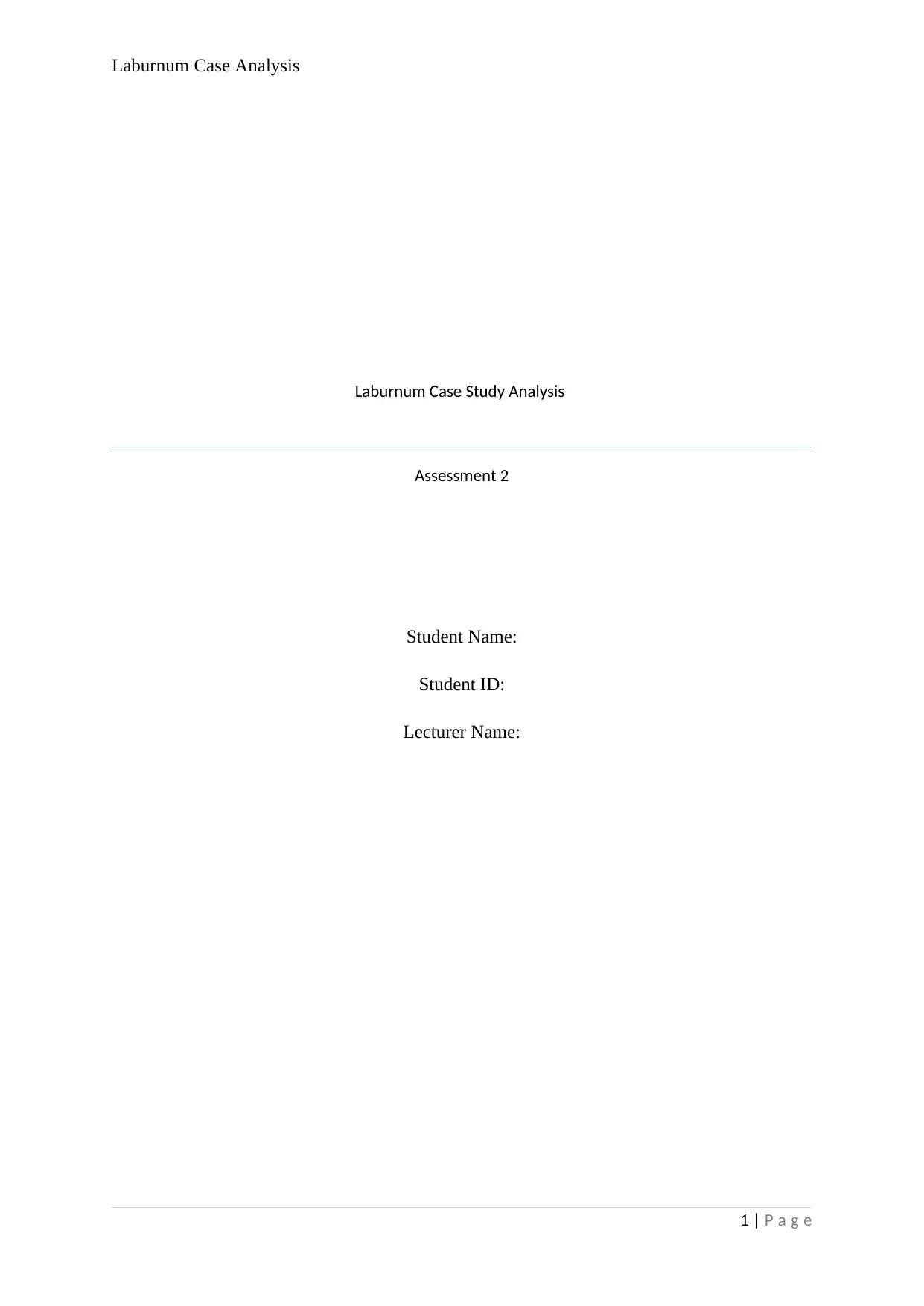
Laburnum Case Analysis
Laburnum Case Study Analysis
Assessment 2
Student Name:
Student ID:
Lecturer Name:
1 | P a g e
Laburnum Case Study Analysis
Assessment 2
Student Name:
Student ID:
Lecturer Name:
1 | P a g e
Secure Best Marks with AI Grader
Need help grading? Try our AI Grader for instant feedback on your assignments.
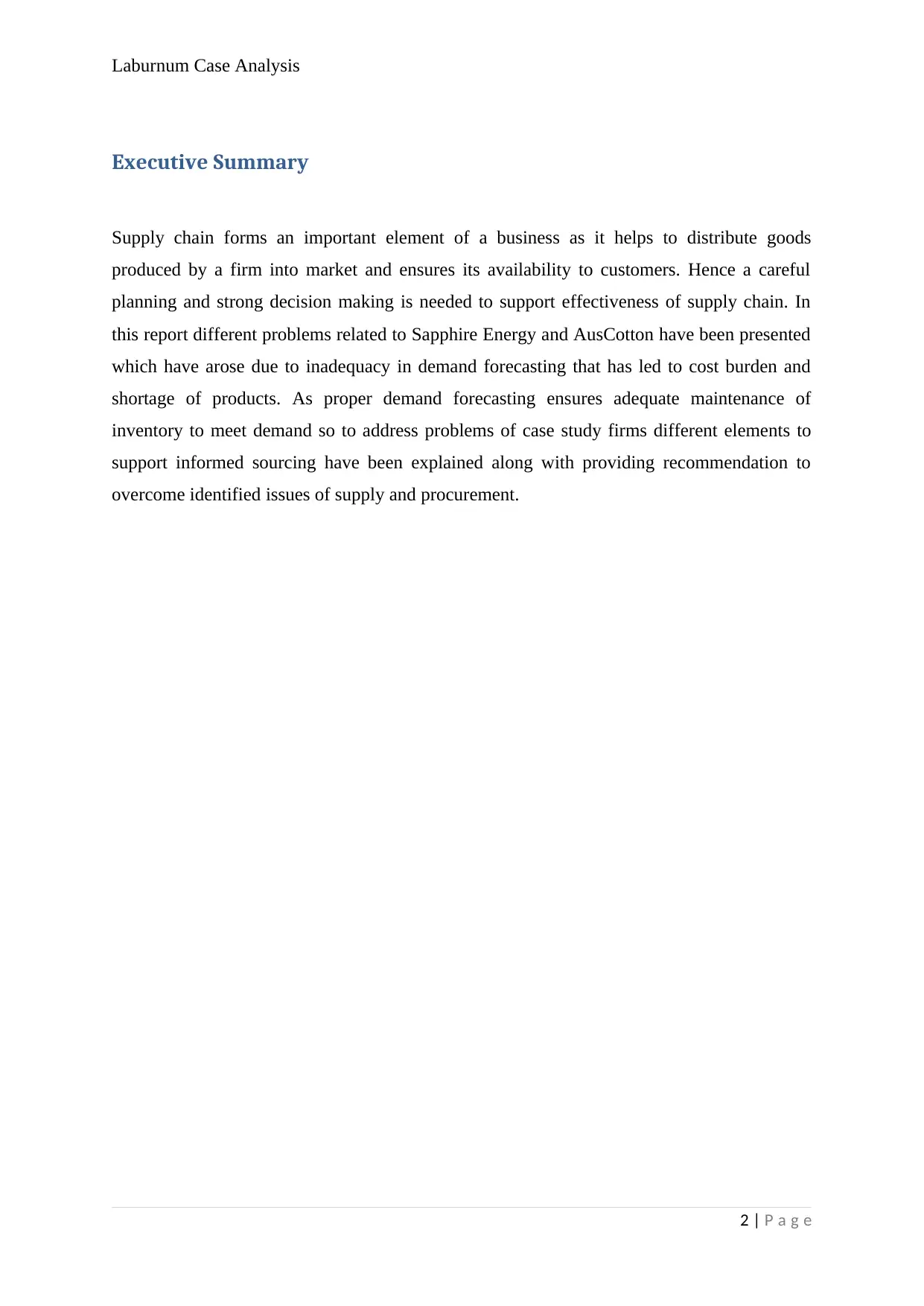
Laburnum Case Analysis
Executive Summary
Supply chain forms an important element of a business as it helps to distribute goods
produced by a firm into market and ensures its availability to customers. Hence a careful
planning and strong decision making is needed to support effectiveness of supply chain. In
this report different problems related to Sapphire Energy and AusCotton have been presented
which have arose due to inadequacy in demand forecasting that has led to cost burden and
shortage of products. As proper demand forecasting ensures adequate maintenance of
inventory to meet demand so to address problems of case study firms different elements to
support informed sourcing have been explained along with providing recommendation to
overcome identified issues of supply and procurement.
2 | P a g e
Executive Summary
Supply chain forms an important element of a business as it helps to distribute goods
produced by a firm into market and ensures its availability to customers. Hence a careful
planning and strong decision making is needed to support effectiveness of supply chain. In
this report different problems related to Sapphire Energy and AusCotton have been presented
which have arose due to inadequacy in demand forecasting that has led to cost burden and
shortage of products. As proper demand forecasting ensures adequate maintenance of
inventory to meet demand so to address problems of case study firms different elements to
support informed sourcing have been explained along with providing recommendation to
overcome identified issues of supply and procurement.
2 | P a g e

Laburnum Case Analysis
Contents
Introduction...........................................................................................................................................3
Discussion..............................................................................................................................................3
Conclusion.............................................................................................................................................9
References...........................................................................................................................................10
3 | P a g e
Contents
Introduction...........................................................................................................................................3
Discussion..............................................................................................................................................3
Conclusion.............................................................................................................................................9
References...........................................................................................................................................10
3 | P a g e
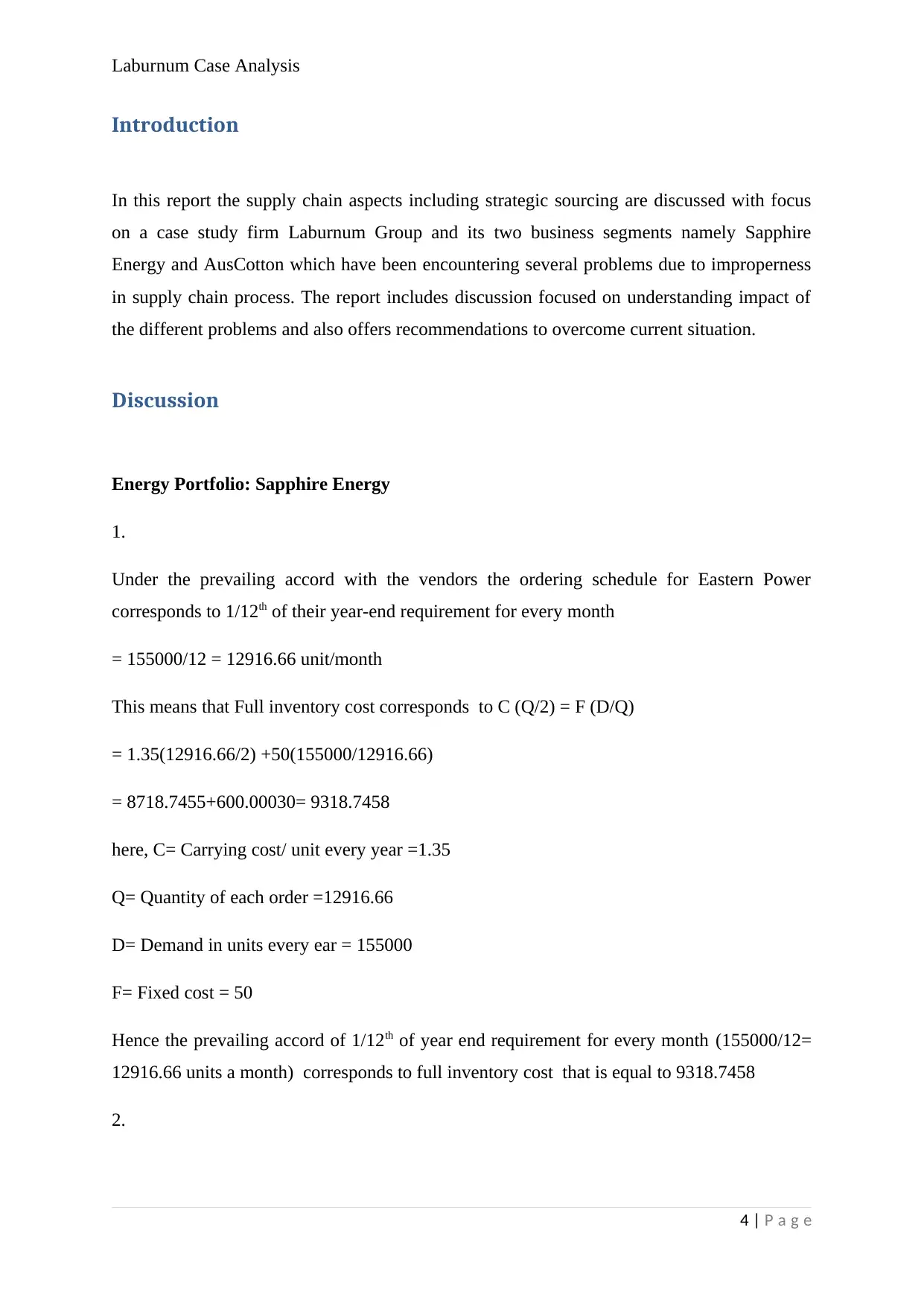
Laburnum Case Analysis
Introduction
In this report the supply chain aspects including strategic sourcing are discussed with focus
on a case study firm Laburnum Group and its two business segments namely Sapphire
Energy and AusCotton which have been encountering several problems due to improperness
in supply chain process. The report includes discussion focused on understanding impact of
the different problems and also offers recommendations to overcome current situation.
Discussion
Energy Portfolio: Sapphire Energy
1.
Under the prevailing accord with the vendors the ordering schedule for Eastern Power
corresponds to 1/12th of their year-end requirement for every month
= 155000/12 = 12916.66 unit/month
This means that Full inventory cost corresponds to C (Q/2) = F (D/Q)
= 1.35(12916.66/2) +50(155000/12916.66)
= 8718.7455+600.00030= 9318.7458
here, C= Carrying cost/ unit every year =1.35
Q= Quantity of each order =12916.66
D= Demand in units every ear = 155000
F= Fixed cost = 50
Hence the prevailing accord of 1/12th of year end requirement for every month (155000/12=
12916.66 units a month) corresponds to full inventory cost that is equal to 9318.7458
2.
4 | P a g e
Introduction
In this report the supply chain aspects including strategic sourcing are discussed with focus
on a case study firm Laburnum Group and its two business segments namely Sapphire
Energy and AusCotton which have been encountering several problems due to improperness
in supply chain process. The report includes discussion focused on understanding impact of
the different problems and also offers recommendations to overcome current situation.
Discussion
Energy Portfolio: Sapphire Energy
1.
Under the prevailing accord with the vendors the ordering schedule for Eastern Power
corresponds to 1/12th of their year-end requirement for every month
= 155000/12 = 12916.66 unit/month
This means that Full inventory cost corresponds to C (Q/2) = F (D/Q)
= 1.35(12916.66/2) +50(155000/12916.66)
= 8718.7455+600.00030= 9318.7458
here, C= Carrying cost/ unit every year =1.35
Q= Quantity of each order =12916.66
D= Demand in units every ear = 155000
F= Fixed cost = 50
Hence the prevailing accord of 1/12th of year end requirement for every month (155000/12=
12916.66 units a month) corresponds to full inventory cost that is equal to 9318.7458
2.
4 | P a g e
Secure Best Marks with AI Grader
Need help grading? Try our AI Grader for instant feedback on your assignments.
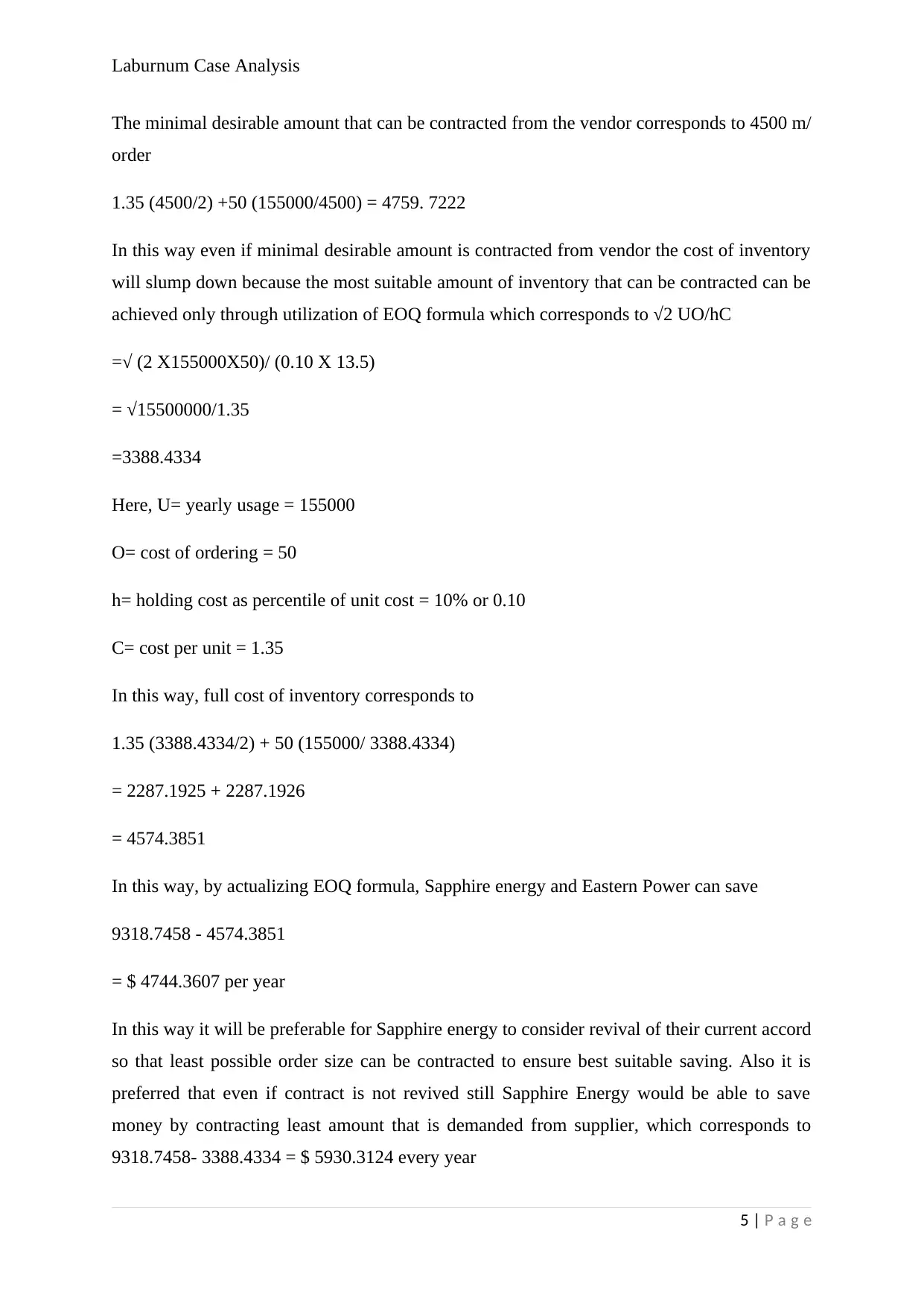
Laburnum Case Analysis
The minimal desirable amount that can be contracted from the vendor corresponds to 4500 m/
order
1.35 (4500/2) +50 (155000/4500) = 4759. 7222
In this way even if minimal desirable amount is contracted from vendor the cost of inventory
will slump down because the most suitable amount of inventory that can be contracted can be
achieved only through utilization of EOQ formula which corresponds to √2 UO/hC
=√ (2 X155000X50)/ (0.10 X 13.5)
= √15500000/1.35
=3388.4334
Here, U= yearly usage = 155000
O= cost of ordering = 50
h= holding cost as percentile of unit cost = 10% or 0.10
C= cost per unit = 1.35
In this way, full cost of inventory corresponds to
1.35 (3388.4334/2) + 50 (155000/ 3388.4334)
= 2287.1925 + 2287.1926
= 4574.3851
In this way, by actualizing EOQ formula, Sapphire energy and Eastern Power can save
9318.7458 - 4574.3851
= $ 4744.3607 per year
In this way it will be preferable for Sapphire energy to consider revival of their current accord
so that least possible order size can be contracted to ensure best suitable saving. Also it is
preferred that even if contract is not revived still Sapphire Energy would be able to save
money by contracting least amount that is demanded from supplier, which corresponds to
9318.7458- 3388.4334 = $ 5930.3124 every year
5 | P a g e
The minimal desirable amount that can be contracted from the vendor corresponds to 4500 m/
order
1.35 (4500/2) +50 (155000/4500) = 4759. 7222
In this way even if minimal desirable amount is contracted from vendor the cost of inventory
will slump down because the most suitable amount of inventory that can be contracted can be
achieved only through utilization of EOQ formula which corresponds to √2 UO/hC
=√ (2 X155000X50)/ (0.10 X 13.5)
= √15500000/1.35
=3388.4334
Here, U= yearly usage = 155000
O= cost of ordering = 50
h= holding cost as percentile of unit cost = 10% or 0.10
C= cost per unit = 1.35
In this way, full cost of inventory corresponds to
1.35 (3388.4334/2) + 50 (155000/ 3388.4334)
= 2287.1925 + 2287.1926
= 4574.3851
In this way, by actualizing EOQ formula, Sapphire energy and Eastern Power can save
9318.7458 - 4574.3851
= $ 4744.3607 per year
In this way it will be preferable for Sapphire energy to consider revival of their current accord
so that least possible order size can be contracted to ensure best suitable saving. Also it is
preferred that even if contract is not revived still Sapphire Energy would be able to save
money by contracting least amount that is demanded from supplier, which corresponds to
9318.7458- 3388.4334 = $ 5930.3124 every year
5 | P a g e

Laburnum Case Analysis
In this way, in order to revive the prevailing accord of ordering system, a new set of rules and
clauses can be forwarded which could ensure more continuing reordering procedure because
of longer lead time. Also it is recommended that Sapphire Energy should consider to put
some efforts and rational management to ensure minimization of a bulk cost each year in
their ordering system.
Clothing Portfolio: AusCotton
1. Strategic sourcing is preferred by enterprises during their supply chain process so that a big
scale of saving can be ensured from lowering of costs as well as minimisation of potential
risk in supply chain. Although appropriate supply chain procedure and actions ensures larger
contribution to meet organisational targets and aims but still in practical manner there are
evidences that several firms do not perform proper strategic planning and actions in context
of efficient supply chain procedure. In actual there have been several examples where
enterprises that conduct strong and focused decisions for supply chain exhibit better
performance through advanced supply chain networks which helps them to better contribute
to the success financial and organisational outcomes for the enterprise in contrast to exiting
competitors in market. Thus on the basis of interpretation of universal business scenario and
positioning of AusCotton in context to its markets and origin of suppliers it can be said that
there are several global concerns that are related to field of strategic sourcing, which are:
Appropriate demand estimation: proper demand estimation is vital as both overstocking can
lead to excess use of capital and warehousing space as well as on contrary understocking has
possibility of losing customers due to inability to meet customer demand (Nordigarden,
Rehme and Chicksand 2015). Hence proper and exact demand forecast is essential and can be
undertaken by different methods, but the best suitable method is based on accurate data and
analytics. In case if a firm like AusCotton has visibility about sales variation as per season or
location or by product or by category or customer kind then these observable information can
help to reveal patterns through which demand can be forecasted and adjusted. Inability of
appropriate data hence can be major concern for strategic sourcing.
Managing margins: as competitive pressure is intense and margins are tight so it is necessary
for firms to bargain best suitable prices and discounts for business. In this context again it is
necessary that appropriate forecasting is performed to attract suppliers preferences. This
means if a firm like AusCotton is unable to commit their forecasted sales volume with
6 | P a g e
In this way, in order to revive the prevailing accord of ordering system, a new set of rules and
clauses can be forwarded which could ensure more continuing reordering procedure because
of longer lead time. Also it is recommended that Sapphire Energy should consider to put
some efforts and rational management to ensure minimization of a bulk cost each year in
their ordering system.
Clothing Portfolio: AusCotton
1. Strategic sourcing is preferred by enterprises during their supply chain process so that a big
scale of saving can be ensured from lowering of costs as well as minimisation of potential
risk in supply chain. Although appropriate supply chain procedure and actions ensures larger
contribution to meet organisational targets and aims but still in practical manner there are
evidences that several firms do not perform proper strategic planning and actions in context
of efficient supply chain procedure. In actual there have been several examples where
enterprises that conduct strong and focused decisions for supply chain exhibit better
performance through advanced supply chain networks which helps them to better contribute
to the success financial and organisational outcomes for the enterprise in contrast to exiting
competitors in market. Thus on the basis of interpretation of universal business scenario and
positioning of AusCotton in context to its markets and origin of suppliers it can be said that
there are several global concerns that are related to field of strategic sourcing, which are:
Appropriate demand estimation: proper demand estimation is vital as both overstocking can
lead to excess use of capital and warehousing space as well as on contrary understocking has
possibility of losing customers due to inability to meet customer demand (Nordigarden,
Rehme and Chicksand 2015). Hence proper and exact demand forecast is essential and can be
undertaken by different methods, but the best suitable method is based on accurate data and
analytics. In case if a firm like AusCotton has visibility about sales variation as per season or
location or by product or by category or customer kind then these observable information can
help to reveal patterns through which demand can be forecasted and adjusted. Inability of
appropriate data hence can be major concern for strategic sourcing.
Managing margins: as competitive pressure is intense and margins are tight so it is necessary
for firms to bargain best suitable prices and discounts for business. In this context again it is
necessary that appropriate forecasting is performed to attract suppliers preferences. This
means if a firm like AusCotton is unable to commit their forecasted sales volume with
6 | P a g e
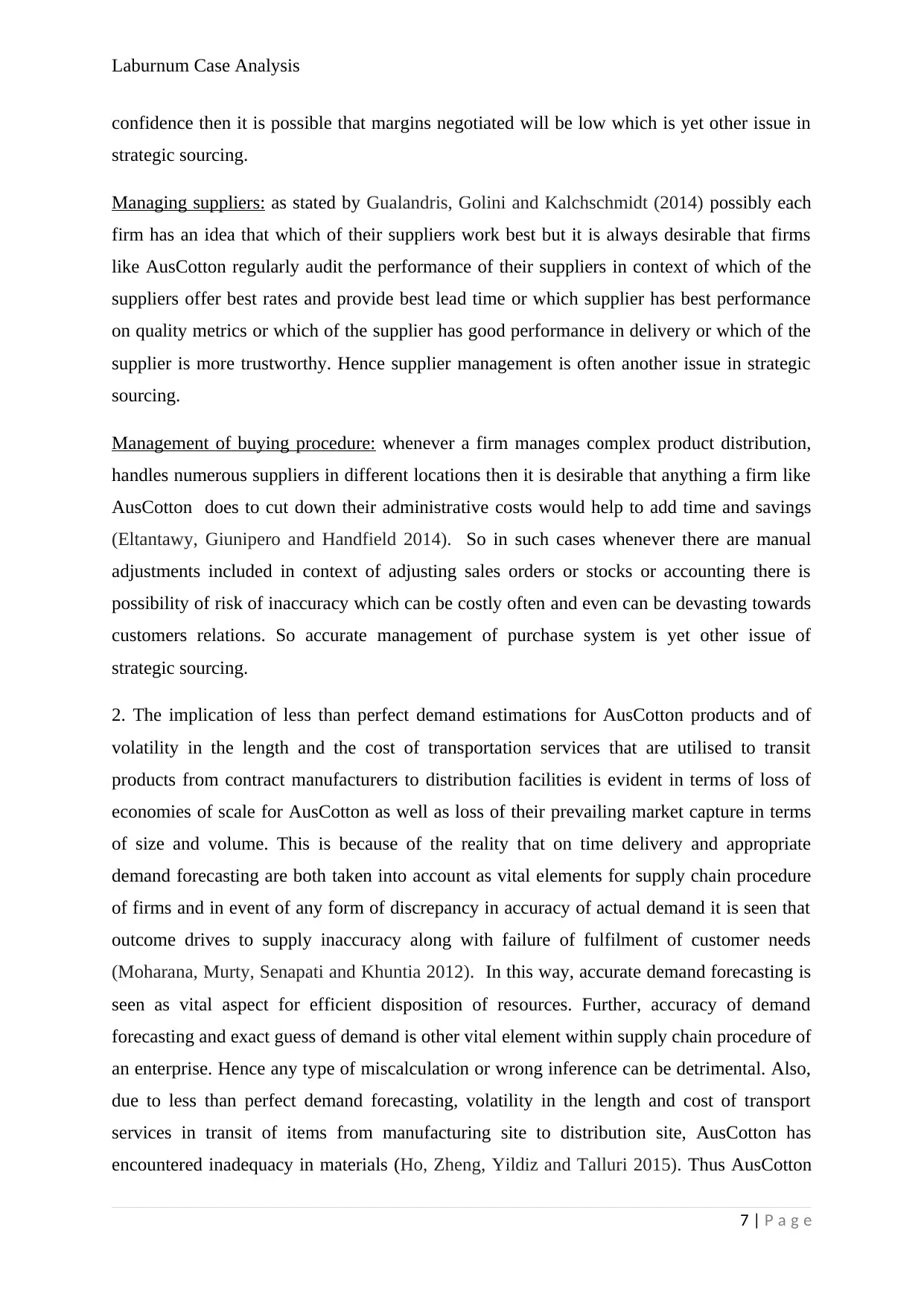
Laburnum Case Analysis
confidence then it is possible that margins negotiated will be low which is yet other issue in
strategic sourcing.
Managing suppliers: as stated by Gualandris, Golini and Kalchschmidt (2014) possibly each
firm has an idea that which of their suppliers work best but it is always desirable that firms
like AusCotton regularly audit the performance of their suppliers in context of which of the
suppliers offer best rates and provide best lead time or which supplier has best performance
on quality metrics or which of the supplier has good performance in delivery or which of the
supplier is more trustworthy. Hence supplier management is often another issue in strategic
sourcing.
Management of buying procedure: whenever a firm manages complex product distribution,
handles numerous suppliers in different locations then it is desirable that anything a firm like
AusCotton does to cut down their administrative costs would help to add time and savings
(Eltantawy, Giunipero and Handfield 2014). So in such cases whenever there are manual
adjustments included in context of adjusting sales orders or stocks or accounting there is
possibility of risk of inaccuracy which can be costly often and even can be devasting towards
customers relations. So accurate management of purchase system is yet other issue of
strategic sourcing.
2. The implication of less than perfect demand estimations for AusCotton products and of
volatility in the length and the cost of transportation services that are utilised to transit
products from contract manufacturers to distribution facilities is evident in terms of loss of
economies of scale for AusCotton as well as loss of their prevailing market capture in terms
of size and volume. This is because of the reality that on time delivery and appropriate
demand forecasting are both taken into account as vital elements for supply chain procedure
of firms and in event of any form of discrepancy in accuracy of actual demand it is seen that
outcome drives to supply inaccuracy along with failure of fulfilment of customer needs
(Moharana, Murty, Senapati and Khuntia 2012). In this way, accurate demand forecasting is
seen as vital aspect for efficient disposition of resources. Further, accuracy of demand
forecasting and exact guess of demand is other vital element within supply chain procedure of
an enterprise. Hence any type of miscalculation or wrong inference can be detrimental. Also,
due to less than perfect demand forecasting, volatility in the length and cost of transport
services in transit of items from manufacturing site to distribution site, AusCotton has
encountered inadequacy in materials (Ho, Zheng, Yildiz and Talluri 2015). Thus AusCotton
7 | P a g e
confidence then it is possible that margins negotiated will be low which is yet other issue in
strategic sourcing.
Managing suppliers: as stated by Gualandris, Golini and Kalchschmidt (2014) possibly each
firm has an idea that which of their suppliers work best but it is always desirable that firms
like AusCotton regularly audit the performance of their suppliers in context of which of the
suppliers offer best rates and provide best lead time or which supplier has best performance
on quality metrics or which of the supplier has good performance in delivery or which of the
supplier is more trustworthy. Hence supplier management is often another issue in strategic
sourcing.
Management of buying procedure: whenever a firm manages complex product distribution,
handles numerous suppliers in different locations then it is desirable that anything a firm like
AusCotton does to cut down their administrative costs would help to add time and savings
(Eltantawy, Giunipero and Handfield 2014). So in such cases whenever there are manual
adjustments included in context of adjusting sales orders or stocks or accounting there is
possibility of risk of inaccuracy which can be costly often and even can be devasting towards
customers relations. So accurate management of purchase system is yet other issue of
strategic sourcing.
2. The implication of less than perfect demand estimations for AusCotton products and of
volatility in the length and the cost of transportation services that are utilised to transit
products from contract manufacturers to distribution facilities is evident in terms of loss of
economies of scale for AusCotton as well as loss of their prevailing market capture in terms
of size and volume. This is because of the reality that on time delivery and appropriate
demand forecasting are both taken into account as vital elements for supply chain procedure
of firms and in event of any form of discrepancy in accuracy of actual demand it is seen that
outcome drives to supply inaccuracy along with failure of fulfilment of customer needs
(Moharana, Murty, Senapati and Khuntia 2012). In this way, accurate demand forecasting is
seen as vital aspect for efficient disposition of resources. Further, accuracy of demand
forecasting and exact guess of demand is other vital element within supply chain procedure of
an enterprise. Hence any type of miscalculation or wrong inference can be detrimental. Also,
due to less than perfect demand forecasting, volatility in the length and cost of transport
services in transit of items from manufacturing site to distribution site, AusCotton has
encountered inadequacy in materials (Ho, Zheng, Yildiz and Talluri 2015). Thus AusCotton
7 | P a g e
Paraphrase This Document
Need a fresh take? Get an instant paraphrase of this document with our AI Paraphraser
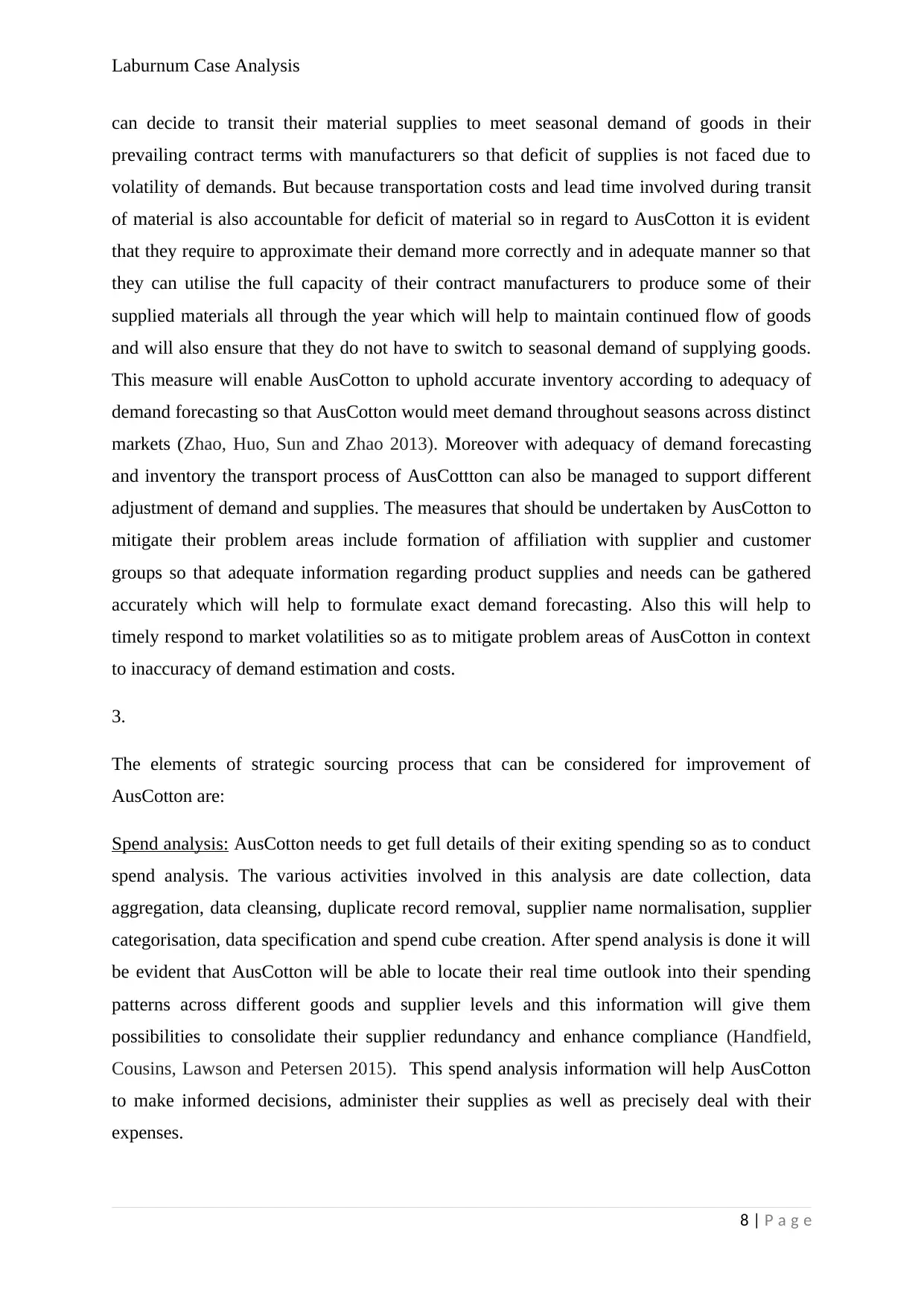
Laburnum Case Analysis
can decide to transit their material supplies to meet seasonal demand of goods in their
prevailing contract terms with manufacturers so that deficit of supplies is not faced due to
volatility of demands. But because transportation costs and lead time involved during transit
of material is also accountable for deficit of material so in regard to AusCotton it is evident
that they require to approximate their demand more correctly and in adequate manner so that
they can utilise the full capacity of their contract manufacturers to produce some of their
supplied materials all through the year which will help to maintain continued flow of goods
and will also ensure that they do not have to switch to seasonal demand of supplying goods.
This measure will enable AusCotton to uphold accurate inventory according to adequacy of
demand forecasting so that AusCotton would meet demand throughout seasons across distinct
markets (Zhao, Huo, Sun and Zhao 2013). Moreover with adequacy of demand forecasting
and inventory the transport process of AusCottton can also be managed to support different
adjustment of demand and supplies. The measures that should be undertaken by AusCotton to
mitigate their problem areas include formation of affiliation with supplier and customer
groups so that adequate information regarding product supplies and needs can be gathered
accurately which will help to formulate exact demand forecasting. Also this will help to
timely respond to market volatilities so as to mitigate problem areas of AusCotton in context
to inaccuracy of demand estimation and costs.
3.
The elements of strategic sourcing process that can be considered for improvement of
AusCotton are:
Spend analysis: AusCotton needs to get full details of their exiting spending so as to conduct
spend analysis. The various activities involved in this analysis are date collection, data
aggregation, data cleansing, duplicate record removal, supplier name normalisation, supplier
categorisation, data specification and spend cube creation. After spend analysis is done it will
be evident that AusCotton will be able to locate their real time outlook into their spending
patterns across different goods and supplier levels and this information will give them
possibilities to consolidate their supplier redundancy and enhance compliance (Handfield,
Cousins, Lawson and Petersen 2015). This spend analysis information will help AusCotton
to make informed decisions, administer their supplies as well as precisely deal with their
expenses.
8 | P a g e
can decide to transit their material supplies to meet seasonal demand of goods in their
prevailing contract terms with manufacturers so that deficit of supplies is not faced due to
volatility of demands. But because transportation costs and lead time involved during transit
of material is also accountable for deficit of material so in regard to AusCotton it is evident
that they require to approximate their demand more correctly and in adequate manner so that
they can utilise the full capacity of their contract manufacturers to produce some of their
supplied materials all through the year which will help to maintain continued flow of goods
and will also ensure that they do not have to switch to seasonal demand of supplying goods.
This measure will enable AusCotton to uphold accurate inventory according to adequacy of
demand forecasting so that AusCotton would meet demand throughout seasons across distinct
markets (Zhao, Huo, Sun and Zhao 2013). Moreover with adequacy of demand forecasting
and inventory the transport process of AusCottton can also be managed to support different
adjustment of demand and supplies. The measures that should be undertaken by AusCotton to
mitigate their problem areas include formation of affiliation with supplier and customer
groups so that adequate information regarding product supplies and needs can be gathered
accurately which will help to formulate exact demand forecasting. Also this will help to
timely respond to market volatilities so as to mitigate problem areas of AusCotton in context
to inaccuracy of demand estimation and costs.
3.
The elements of strategic sourcing process that can be considered for improvement of
AusCotton are:
Spend analysis: AusCotton needs to get full details of their exiting spending so as to conduct
spend analysis. The various activities involved in this analysis are date collection, data
aggregation, data cleansing, duplicate record removal, supplier name normalisation, supplier
categorisation, data specification and spend cube creation. After spend analysis is done it will
be evident that AusCotton will be able to locate their real time outlook into their spending
patterns across different goods and supplier levels and this information will give them
possibilities to consolidate their supplier redundancy and enhance compliance (Handfield,
Cousins, Lawson and Petersen 2015). This spend analysis information will help AusCotton
to make informed decisions, administer their supplies as well as precisely deal with their
expenses.
8 | P a g e
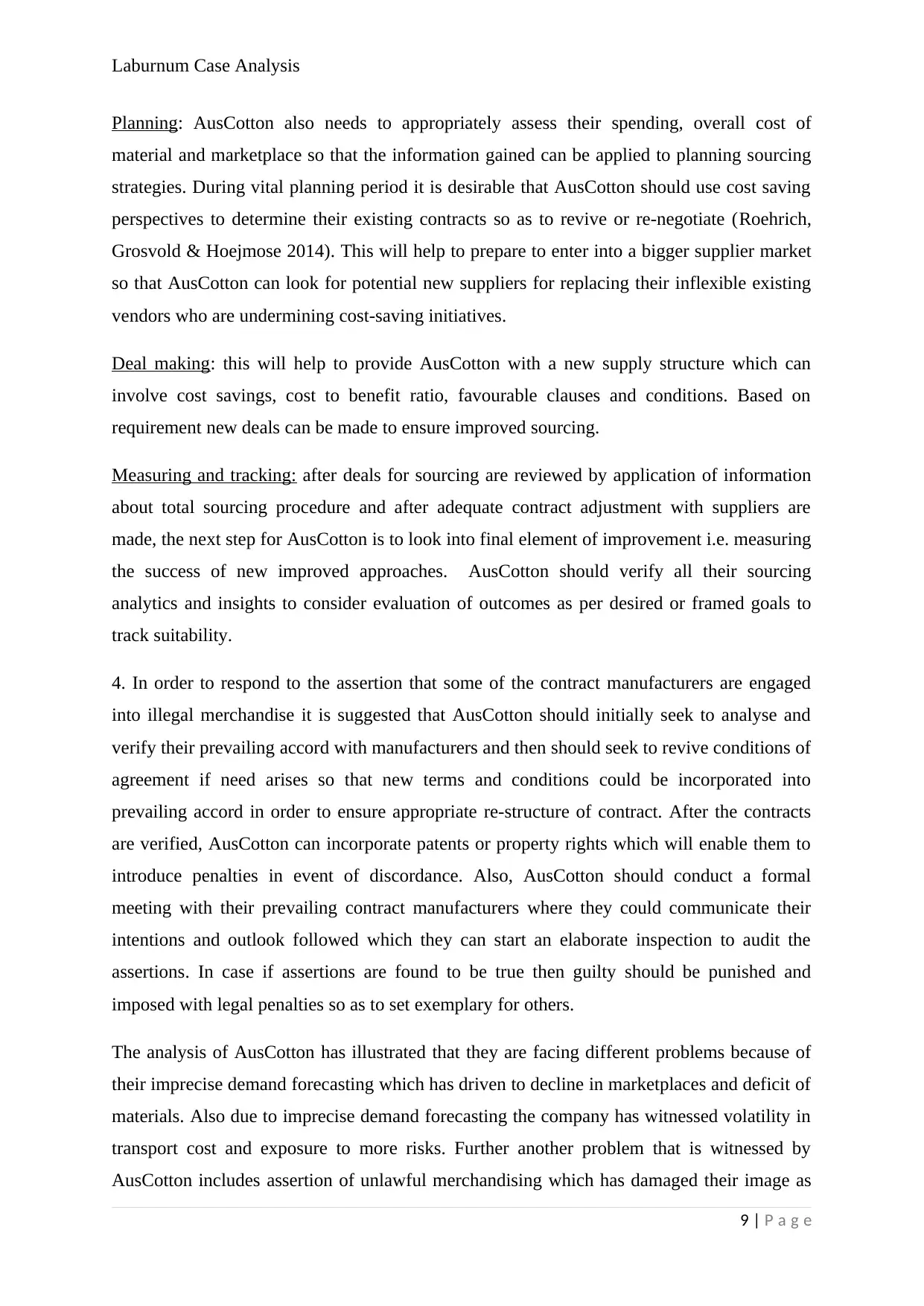
Laburnum Case Analysis
Planning: AusCotton also needs to appropriately assess their spending, overall cost of
material and marketplace so that the information gained can be applied to planning sourcing
strategies. During vital planning period it is desirable that AusCotton should use cost saving
perspectives to determine their existing contracts so as to revive or re-negotiate (Roehrich,
Grosvold & Hoejmose 2014). This will help to prepare to enter into a bigger supplier market
so that AusCotton can look for potential new suppliers for replacing their inflexible existing
vendors who are undermining cost-saving initiatives.
Deal making: this will help to provide AusCotton with a new supply structure which can
involve cost savings, cost to benefit ratio, favourable clauses and conditions. Based on
requirement new deals can be made to ensure improved sourcing.
Measuring and tracking: after deals for sourcing are reviewed by application of information
about total sourcing procedure and after adequate contract adjustment with suppliers are
made, the next step for AusCotton is to look into final element of improvement i.e. measuring
the success of new improved approaches. AusCotton should verify all their sourcing
analytics and insights to consider evaluation of outcomes as per desired or framed goals to
track suitability.
4. In order to respond to the assertion that some of the contract manufacturers are engaged
into illegal merchandise it is suggested that AusCotton should initially seek to analyse and
verify their prevailing accord with manufacturers and then should seek to revive conditions of
agreement if need arises so that new terms and conditions could be incorporated into
prevailing accord in order to ensure appropriate re-structure of contract. After the contracts
are verified, AusCotton can incorporate patents or property rights which will enable them to
introduce penalties in event of discordance. Also, AusCotton should conduct a formal
meeting with their prevailing contract manufacturers where they could communicate their
intentions and outlook followed which they can start an elaborate inspection to audit the
assertions. In case if assertions are found to be true then guilty should be punished and
imposed with legal penalties so as to set exemplary for others.
The analysis of AusCotton has illustrated that they are facing different problems because of
their imprecise demand forecasting which has driven to decline in marketplaces and deficit of
materials. Also due to imprecise demand forecasting the company has witnessed volatility in
transport cost and exposure to more risks. Further another problem that is witnessed by
AusCotton includes assertion of unlawful merchandising which has damaged their image as
9 | P a g e
Planning: AusCotton also needs to appropriately assess their spending, overall cost of
material and marketplace so that the information gained can be applied to planning sourcing
strategies. During vital planning period it is desirable that AusCotton should use cost saving
perspectives to determine their existing contracts so as to revive or re-negotiate (Roehrich,
Grosvold & Hoejmose 2014). This will help to prepare to enter into a bigger supplier market
so that AusCotton can look for potential new suppliers for replacing their inflexible existing
vendors who are undermining cost-saving initiatives.
Deal making: this will help to provide AusCotton with a new supply structure which can
involve cost savings, cost to benefit ratio, favourable clauses and conditions. Based on
requirement new deals can be made to ensure improved sourcing.
Measuring and tracking: after deals for sourcing are reviewed by application of information
about total sourcing procedure and after adequate contract adjustment with suppliers are
made, the next step for AusCotton is to look into final element of improvement i.e. measuring
the success of new improved approaches. AusCotton should verify all their sourcing
analytics and insights to consider evaluation of outcomes as per desired or framed goals to
track suitability.
4. In order to respond to the assertion that some of the contract manufacturers are engaged
into illegal merchandise it is suggested that AusCotton should initially seek to analyse and
verify their prevailing accord with manufacturers and then should seek to revive conditions of
agreement if need arises so that new terms and conditions could be incorporated into
prevailing accord in order to ensure appropriate re-structure of contract. After the contracts
are verified, AusCotton can incorporate patents or property rights which will enable them to
introduce penalties in event of discordance. Also, AusCotton should conduct a formal
meeting with their prevailing contract manufacturers where they could communicate their
intentions and outlook followed which they can start an elaborate inspection to audit the
assertions. In case if assertions are found to be true then guilty should be punished and
imposed with legal penalties so as to set exemplary for others.
The analysis of AusCotton has illustrated that they are facing different problems because of
their imprecise demand forecasting which has driven to decline in marketplaces and deficit of
materials. Also due to imprecise demand forecasting the company has witnessed volatility in
transport cost and exposure to more risks. Further another problem that is witnessed by
AusCotton includes assertion of unlawful merchandising which has damaged their image as
9 | P a g e
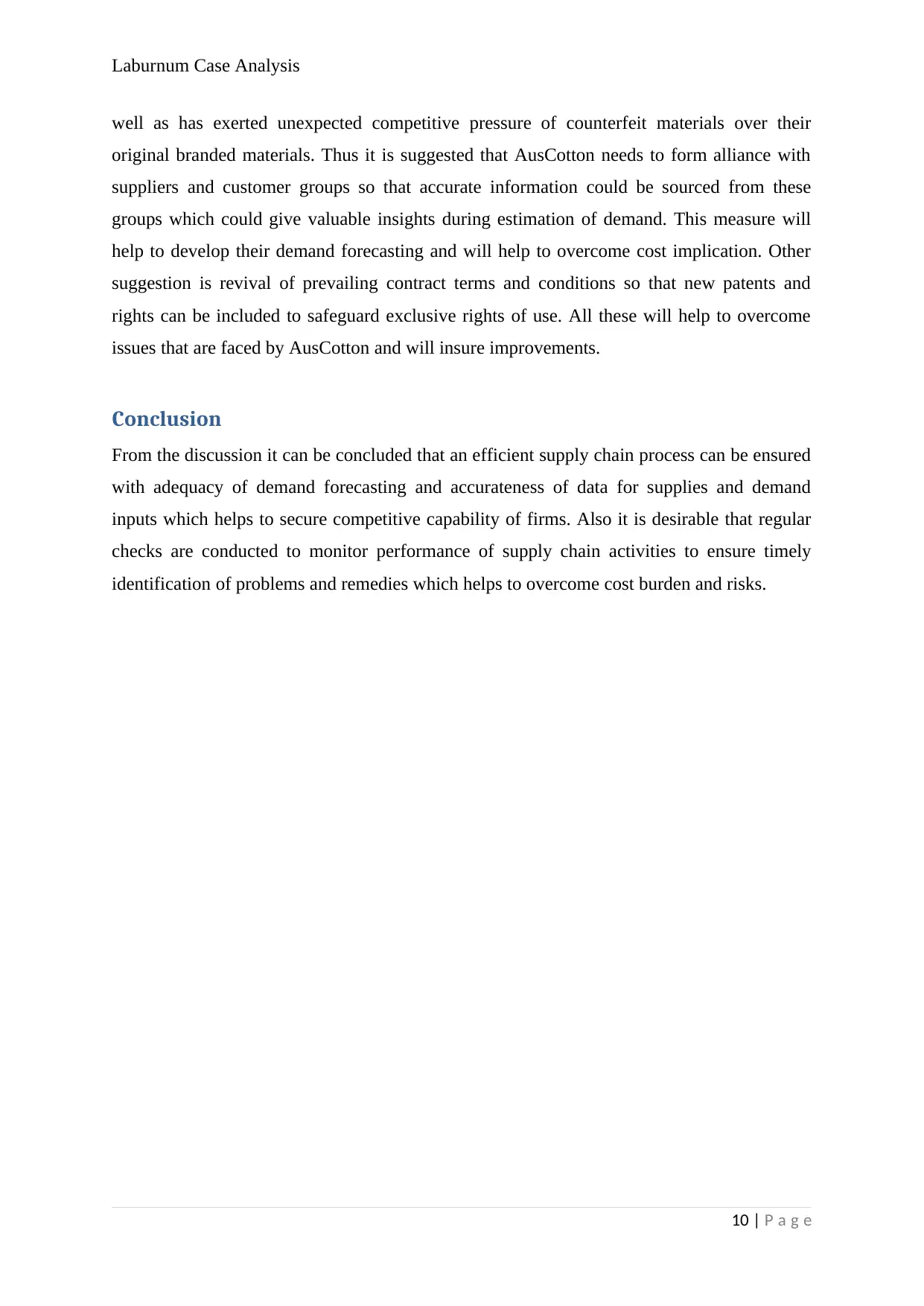
Laburnum Case Analysis
well as has exerted unexpected competitive pressure of counterfeit materials over their
original branded materials. Thus it is suggested that AusCotton needs to form alliance with
suppliers and customer groups so that accurate information could be sourced from these
groups which could give valuable insights during estimation of demand. This measure will
help to develop their demand forecasting and will help to overcome cost implication. Other
suggestion is revival of prevailing contract terms and conditions so that new patents and
rights can be included to safeguard exclusive rights of use. All these will help to overcome
issues that are faced by AusCotton and will insure improvements.
Conclusion
From the discussion it can be concluded that an efficient supply chain process can be ensured
with adequacy of demand forecasting and accurateness of data for supplies and demand
inputs which helps to secure competitive capability of firms. Also it is desirable that regular
checks are conducted to monitor performance of supply chain activities to ensure timely
identification of problems and remedies which helps to overcome cost burden and risks.
10 | P a g e
well as has exerted unexpected competitive pressure of counterfeit materials over their
original branded materials. Thus it is suggested that AusCotton needs to form alliance with
suppliers and customer groups so that accurate information could be sourced from these
groups which could give valuable insights during estimation of demand. This measure will
help to develop their demand forecasting and will help to overcome cost implication. Other
suggestion is revival of prevailing contract terms and conditions so that new patents and
rights can be included to safeguard exclusive rights of use. All these will help to overcome
issues that are faced by AusCotton and will insure improvements.
Conclusion
From the discussion it can be concluded that an efficient supply chain process can be ensured
with adequacy of demand forecasting and accurateness of data for supplies and demand
inputs which helps to secure competitive capability of firms. Also it is desirable that regular
checks are conducted to monitor performance of supply chain activities to ensure timely
identification of problems and remedies which helps to overcome cost burden and risks.
10 | P a g e
Secure Best Marks with AI Grader
Need help grading? Try our AI Grader for instant feedback on your assignments.
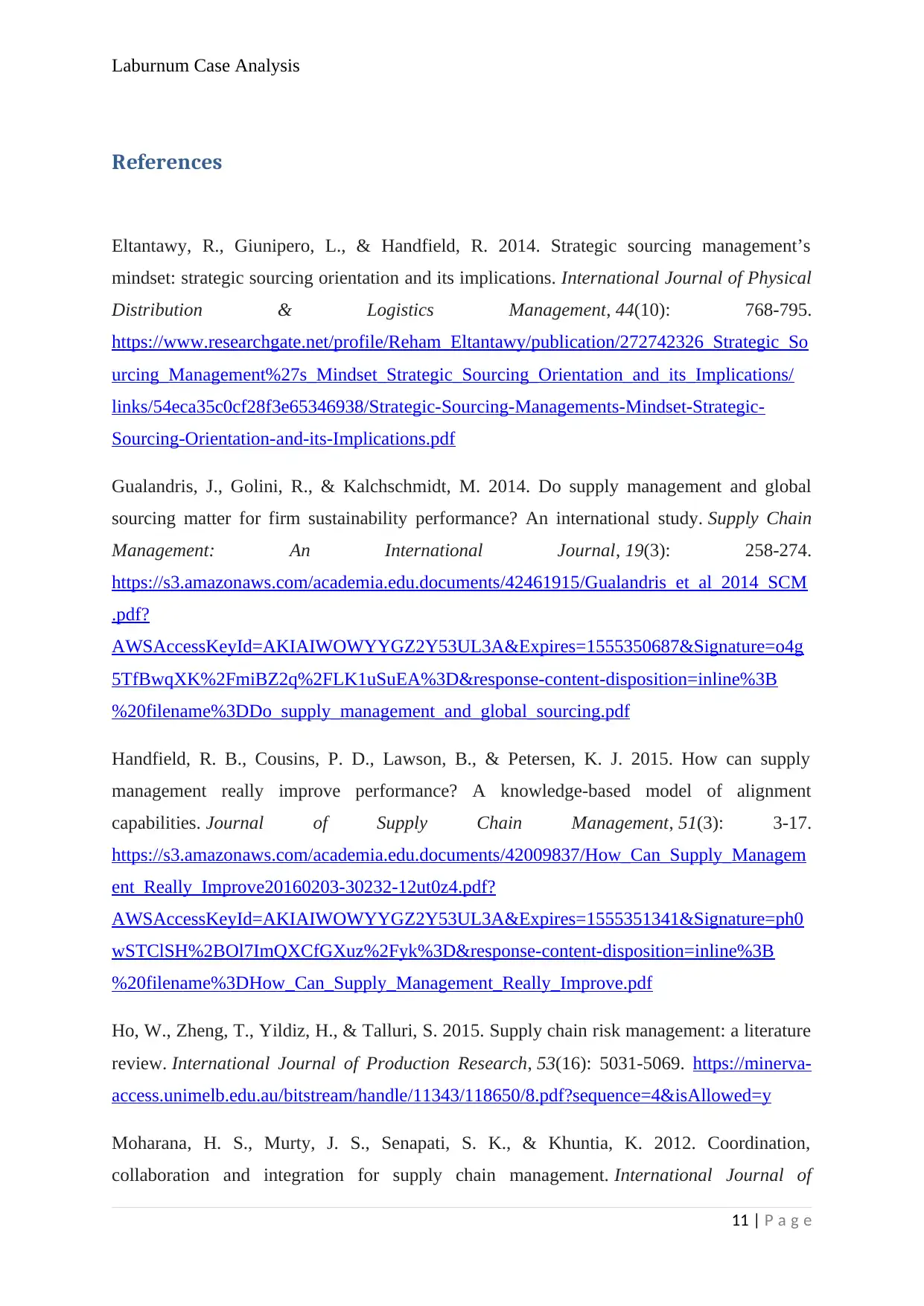
Laburnum Case Analysis
References
Eltantawy, R., Giunipero, L., & Handfield, R. 2014. Strategic sourcing management’s
mindset: strategic sourcing orientation and its implications. International Journal of Physical
Distribution & Logistics Management, 44(10): 768-795.
https://www.researchgate.net/profile/Reham_Eltantawy/publication/272742326_Strategic_So
urcing_Management%27s_Mindset_Strategic_Sourcing_Orientation_and_its_Implications/
links/54eca35c0cf28f3e65346938/Strategic-Sourcing-Managements-Mindset-Strategic-
Sourcing-Orientation-and-its-Implications.pdf
Gualandris, J., Golini, R., & Kalchschmidt, M. 2014. Do supply management and global
sourcing matter for firm sustainability performance? An international study. Supply Chain
Management: An International Journal, 19(3): 258-274.
https://s3.amazonaws.com/academia.edu.documents/42461915/Gualandris_et_al_2014_SCM
.pdf?
AWSAccessKeyId=AKIAIWOWYYGZ2Y53UL3A&Expires=1555350687&Signature=o4g
5TfBwqXK%2FmiBZ2q%2FLK1uSuEA%3D&response-content-disposition=inline%3B
%20filename%3DDo_supply_management_and_global_sourcing.pdf
Handfield, R. B., Cousins, P. D., Lawson, B., & Petersen, K. J. 2015. How can supply
management really improve performance? A knowledge‐based model of alignment
capabilities. Journal of Supply Chain Management, 51(3): 3-17.
https://s3.amazonaws.com/academia.edu.documents/42009837/How_Can_Supply_Managem
ent_Really_Improve20160203-30232-12ut0z4.pdf?
AWSAccessKeyId=AKIAIWOWYYGZ2Y53UL3A&Expires=1555351341&Signature=ph0
wSTClSH%2BOl7ImQXCfGXuz%2Fyk%3D&response-content-disposition=inline%3B
%20filename%3DHow_Can_Supply_Management_Really_Improve.pdf
Ho, W., Zheng, T., Yildiz, H., & Talluri, S. 2015. Supply chain risk management: a literature
review. International Journal of Production Research, 53(16): 5031-5069. https://minerva-
access.unimelb.edu.au/bitstream/handle/11343/118650/8.pdf?sequence=4&isAllowed=y
Moharana, H. S., Murty, J. S., Senapati, S. K., & Khuntia, K. 2012. Coordination,
collaboration and integration for supply chain management. International Journal of
11 | P a g e
References
Eltantawy, R., Giunipero, L., & Handfield, R. 2014. Strategic sourcing management’s
mindset: strategic sourcing orientation and its implications. International Journal of Physical
Distribution & Logistics Management, 44(10): 768-795.
https://www.researchgate.net/profile/Reham_Eltantawy/publication/272742326_Strategic_So
urcing_Management%27s_Mindset_Strategic_Sourcing_Orientation_and_its_Implications/
links/54eca35c0cf28f3e65346938/Strategic-Sourcing-Managements-Mindset-Strategic-
Sourcing-Orientation-and-its-Implications.pdf
Gualandris, J., Golini, R., & Kalchschmidt, M. 2014. Do supply management and global
sourcing matter for firm sustainability performance? An international study. Supply Chain
Management: An International Journal, 19(3): 258-274.
https://s3.amazonaws.com/academia.edu.documents/42461915/Gualandris_et_al_2014_SCM
.pdf?
AWSAccessKeyId=AKIAIWOWYYGZ2Y53UL3A&Expires=1555350687&Signature=o4g
5TfBwqXK%2FmiBZ2q%2FLK1uSuEA%3D&response-content-disposition=inline%3B
%20filename%3DDo_supply_management_and_global_sourcing.pdf
Handfield, R. B., Cousins, P. D., Lawson, B., & Petersen, K. J. 2015. How can supply
management really improve performance? A knowledge‐based model of alignment
capabilities. Journal of Supply Chain Management, 51(3): 3-17.
https://s3.amazonaws.com/academia.edu.documents/42009837/How_Can_Supply_Managem
ent_Really_Improve20160203-30232-12ut0z4.pdf?
AWSAccessKeyId=AKIAIWOWYYGZ2Y53UL3A&Expires=1555351341&Signature=ph0
wSTClSH%2BOl7ImQXCfGXuz%2Fyk%3D&response-content-disposition=inline%3B
%20filename%3DHow_Can_Supply_Management_Really_Improve.pdf
Ho, W., Zheng, T., Yildiz, H., & Talluri, S. 2015. Supply chain risk management: a literature
review. International Journal of Production Research, 53(16): 5031-5069. https://minerva-
access.unimelb.edu.au/bitstream/handle/11343/118650/8.pdf?sequence=4&isAllowed=y
Moharana, H. S., Murty, J. S., Senapati, S. K., & Khuntia, K. 2012. Coordination,
collaboration and integration for supply chain management. International Journal of
11 | P a g e
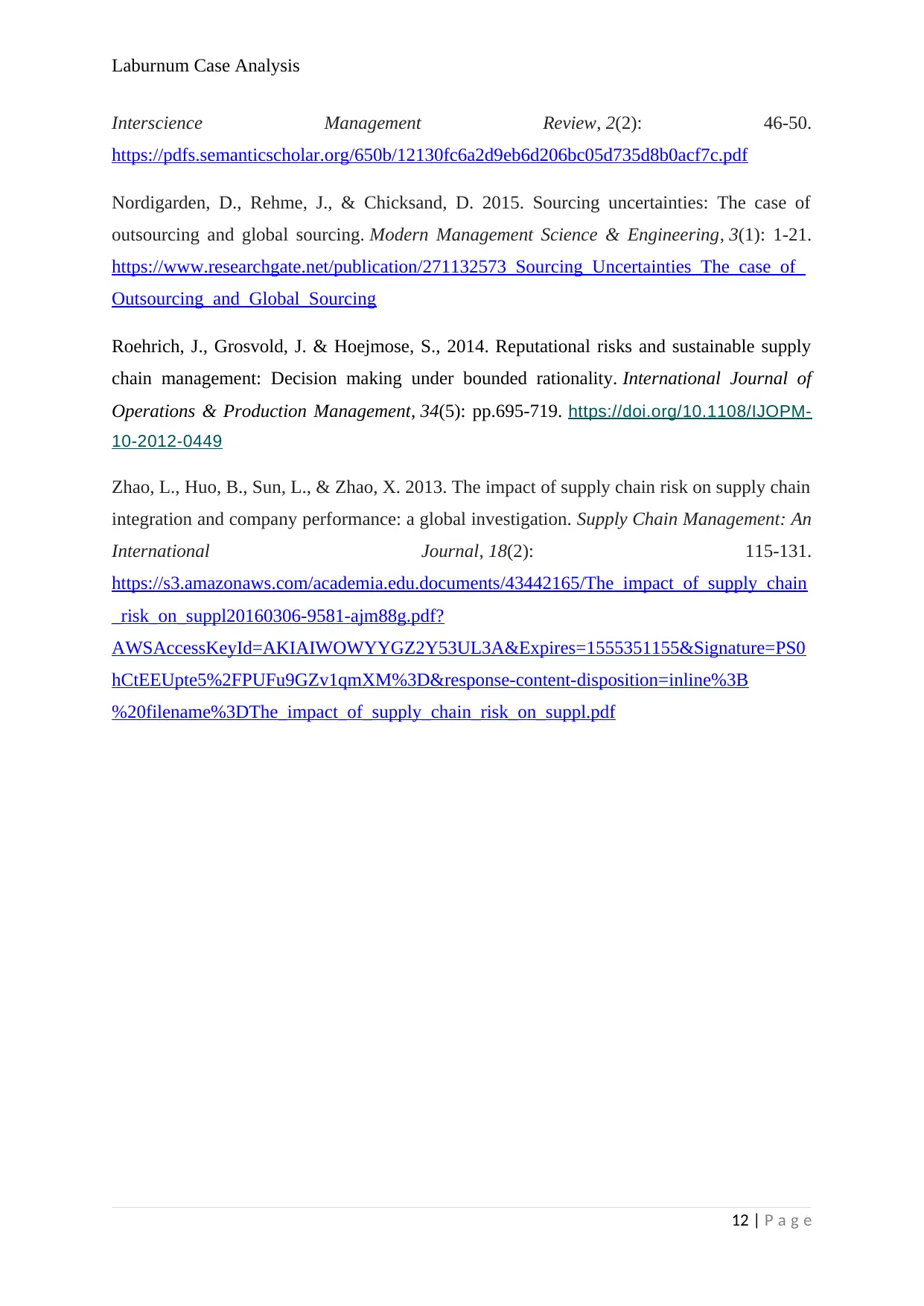
Laburnum Case Analysis
Interscience Management Review, 2(2): 46-50.
https://pdfs.semanticscholar.org/650b/12130fc6a2d9eb6d206bc05d735d8b0acf7c.pdf
Nordigarden, D., Rehme, J., & Chicksand, D. 2015. Sourcing uncertainties: The case of
outsourcing and global sourcing. Modern Management Science & Engineering, 3(1): 1-21.
https://www.researchgate.net/publication/271132573_Sourcing_Uncertainties_The_case_of_
Outsourcing_and_Global_Sourcing
Roehrich, J., Grosvold, J. & Hoejmose, S., 2014. Reputational risks and sustainable supply
chain management: Decision making under bounded rationality. International Journal of
Operations & Production Management, 34(5): pp.695-719. https://doi.org/10.1108/IJOPM-
10-2012-0449
Zhao, L., Huo, B., Sun, L., & Zhao, X. 2013. The impact of supply chain risk on supply chain
integration and company performance: a global investigation. Supply Chain Management: An
International Journal, 18(2): 115-131.
https://s3.amazonaws.com/academia.edu.documents/43442165/The_impact_of_supply_chain
_risk_on_suppl20160306-9581-ajm88g.pdf?
AWSAccessKeyId=AKIAIWOWYYGZ2Y53UL3A&Expires=1555351155&Signature=PS0
hCtEEUpte5%2FPUFu9GZv1qmXM%3D&response-content-disposition=inline%3B
%20filename%3DThe_impact_of_supply_chain_risk_on_suppl.pdf
12 | P a g e
Interscience Management Review, 2(2): 46-50.
https://pdfs.semanticscholar.org/650b/12130fc6a2d9eb6d206bc05d735d8b0acf7c.pdf
Nordigarden, D., Rehme, J., & Chicksand, D. 2015. Sourcing uncertainties: The case of
outsourcing and global sourcing. Modern Management Science & Engineering, 3(1): 1-21.
https://www.researchgate.net/publication/271132573_Sourcing_Uncertainties_The_case_of_
Outsourcing_and_Global_Sourcing
Roehrich, J., Grosvold, J. & Hoejmose, S., 2014. Reputational risks and sustainable supply
chain management: Decision making under bounded rationality. International Journal of
Operations & Production Management, 34(5): pp.695-719. https://doi.org/10.1108/IJOPM-
10-2012-0449
Zhao, L., Huo, B., Sun, L., & Zhao, X. 2013. The impact of supply chain risk on supply chain
integration and company performance: a global investigation. Supply Chain Management: An
International Journal, 18(2): 115-131.
https://s3.amazonaws.com/academia.edu.documents/43442165/The_impact_of_supply_chain
_risk_on_suppl20160306-9581-ajm88g.pdf?
AWSAccessKeyId=AKIAIWOWYYGZ2Y53UL3A&Expires=1555351155&Signature=PS0
hCtEEUpte5%2FPUFu9GZv1qmXM%3D&response-content-disposition=inline%3B
%20filename%3DThe_impact_of_supply_chain_risk_on_suppl.pdf
12 | P a g e
1 out of 12
Related Documents
Your All-in-One AI-Powered Toolkit for Academic Success.
+13062052269
info@desklib.com
Available 24*7 on WhatsApp / Email
![[object Object]](/_next/static/media/star-bottom.7253800d.svg)
Unlock your academic potential
© 2024 | Zucol Services PVT LTD | All rights reserved.



